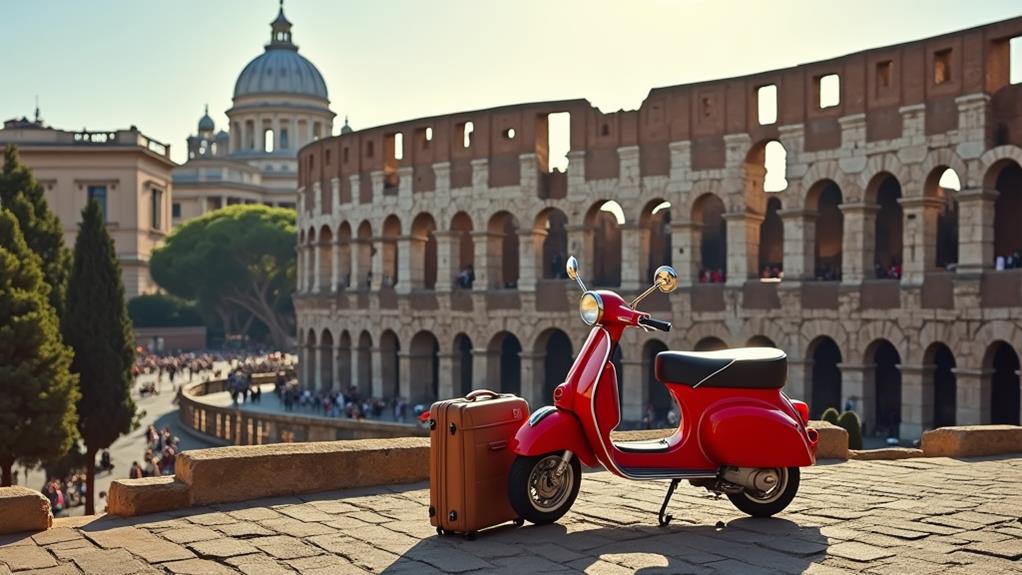Is the rumor true that Rome can be a challenging city to navigate for first-time travelers? As you plan your trip, you're likely to come across numerous tips and tricks for making the most of your Roman adventure. But where do you start? From prioritizing must-see attractions to avoiding common tourist pitfalls, there's a lot to consider. As you prepare to immerse yourself in Rome's rich history, art, and culture, it's essential to separate fact from fiction and focus on the most valuable advice – and that's exactly what you'll discover in the information that follows.
Contents
- 1 Key Takeaways
- 2 Before You Leave Rome
- 3 Best Time to Visit Rome
- 4 Rome Public Transportation
- 5 Must See Rome Attractions
- 6 Exploring Rome Neighborhoods
- 7 Rome Food and Drink
- 8 Safety Tips for Tourists
- 9 Budgeting for Rome Travel
- 10 Rome Accommodation Options
- 11 Off the Beaten Path
- 12 Frequently Asked Questions
- 13 Conclusion
Key Takeaways
- Double-check essentials like passport, charger, and adapter before departing for Rome.
- Validate metro tickets before entering the platform to avoid fines in Rome.
- Explore Rome's unique neighborhoods, such as Trastevere and Monti, to discover local culture.
- Be mindful of pickpocket hotspots in crowded tourist areas and public transportation in Rome.
- Allocate a daily budget of €100-€150 per person, depending on travel style and preferences.
Before You Leave Rome
As you prepare to leave Rome, don't forget to take care of a few essentials to ensure a smooth departure.
Double-check your Packing Essentials, making sure you have all the necessary items, such as your passport, phone charger, and travel adapter. It's also a good idea to gather any items you've borrowed from your accommodation, like towels or a hair dryer.
Next, do a Last Minute Check of your room to ensure you haven't left anything behind.
This includes checking the bathroom, closet, and under the bed. It's easy to overlook small items like phone chargers or headphones, so take your time and thoroughly inspect the space.
Additionally, confirm your flight details, check the weather forecast for your next destination, and exchange any remaining euros for your next currency.
If you have any items you purchased in Rome that didn't fit in your luggage, consider shipping them home or donating them to a local charity.
Best Time to Visit Rome
Rome is a year-round destination, but if you're looking to make the most of your trip, timing is everything.
When planning your visit, consider the time of year that suits you best. The peak tourist season in Rome is June to August, but these months can be hot and crowded.
On the other hand, the shoulder season (April to May and September to October) offers pleasant weather and smaller crowds, making it an ideal time to explore the city.
If you're interested in attending Spring festivals, visit Rome in April or May.
You'll get to experience the Eternal City in full bloom, and enjoy events like the Rome Marathon and the Festa della Primavera.
Some key factors to consider when deciding the best time to visit Rome include:
- Weather: Spring and autumn are generally mild and pleasant, while winters can be cool and rainy.
- Crowds: Peak season means larger crowds and longer lines, while the shoulder season offers a more relaxed atmosphere.
- Events: Rome hosts various festivals and events throughout the year, including Spring festivals and summer concerts.
- Budget: Prices for accommodations and flights tend to be lower during the off-season.
Rome Public Transportation
You're ready to explore Rome, but first, you need to navigate its public transportation system.
Rome's metro system is efficient and convenient, with three lines that cover much of the city.
To ride the metro, you'll need to purchase a ticket, which can be bought at any metro station or a newsstand, and understanding the fare system will help you save time and money.
Rome Metro System
Only three metro lines serve Rome, a surprisingly sparse network given the city's size and popularity.
As you navigate the city, it's essential to understand how to make the most of this limited system.
When using the metro, be mindful of Metro Etiquette.
For example, give up your seat to elderly or disabled passengers, and avoid eating on the train.
Following these simple rules will help you blend in with the locals.
*Rush hour is best avoided*: Try to plan your journeys outside of peak hours (7-9 am and 5-7 pm) to minimize congestion and delays.
- *Use the metro map*: Familiarize yourself with the metro map to plan your route in advance and avoid getting lost.
- *Validate your ticket*: Ensure you validate your ticket before entering the metro platform to avoid fines.
- *Keep an eye on your belongings*: Pickpocketing is a common issue in crowded trains, so be mindful of your belongings at all times.
Fares and Tickets
Navigating Rome's public transportation system can be straightforward once you understand the fares and ticket options.
You'll find Ticket Machines conveniently located at metro stations, tram stops, and major bus terminals. These machines allow you to purchase single tickets, daily passes, or longer-term passes.
You can also buy tickets at tobacco shops, newsstands, and some convenience stores displaying the "Tabacchi" sign.
The standard single ticket, known as a BIT, costs around €1.50 and is valid for 100 minutes.
You can also purchase a daily pass, called a Roma 24H, which costs around €7 for unlimited travel within 24 hours.
Weekly passes, called Roma 7, offer even more value if you plan to use public transportation extensively.
Don't forget to validate your ticket before boarding by stamping it in the yellow validation machines.
Fare Discounts are available for children, seniors, and groups, so be sure to ask about these when purchasing your tickets.
With the right ticket and a bit of planning, you'll be zipping around Rome like a pro.
Must See Rome Attractions
Rome's rich history and architecture make it a city like no other, and the must-see attractions are a testament to its enduring legacy.
As you explore Rome, you'll find yourself surrounded by iconic landmarks that are steeped in history and culture.
From ancient ruins to baroque fountains, there's no shortage of breathtaking sights to discover.
Some of the top Rome landmarks and hidden gems to add to your itinerary include:
- The Colosseum: This ancient amphitheater is one of Rome's most recognizable symbols and a must-visit for history buffs.
- The Trevi Fountain: Toss a coin into this beautiful baroque fountain and make a wish – legend has it that you'll one day return to Rome.
- The Pantheon: This ancient temple is one of the best-preserved ancient buildings in Rome and is a must-see for architecture enthusiasts.
- The Villa Borghese Gardens: Escape the hustle and bustle of the city with a stroll through these beautiful gardens, which offer stunning views of the city.
Exploring Rome Neighborhoods
Beyond the iconic landmarks, Rome's unique neighborhoods offer a glimpse into the city's vibrant culture and daily life.
As you wander through Rome's districts, you'll discover hidden gems that reveal the authentic spirit of the city. Each neighborhood has its own distinct character, from the charming piazzas of Trastevere to the bohemian vibe of Monti.
The historic center of Rome is a treasure trove of neighborhoods, each with its own unique charm.
Explore the narrow streets of Campo de' Fiori, where you'll find quaint shops and bustling markets. The trendy neighborhood of Testaccio is a hotspot for nightlife and entertainment, while the upscale district of Parioli offers a glimpse into Rome's high-end lifestyle.
When exploring Rome's neighborhoods, be sure to venture off the beaten path.
You'll stumble upon hidden gems, such as the charming Santa Maria Maggiore church in the Esquilino district or the picturesque Villa Borghese park in the Parioli district. By exploring Rome's neighborhoods, you'll experience the city like a local and discover a side of Rome that's often overlooked by tourists.
Rome Food and Drink
As you explore Rome's neighborhoods, you'll inevitably crave authentic Italian flavors.
Traditional Italian cuisine is a defining aspect of Roman culture, with popular dishes like carbonara, amatriciana, and cacio e pepe originating from this region.
You'll also want to try the city's popular local beverages, such as espresso, cappuccino, and limoncello, which complement Rome's culinary delights perfectly.
Traditional Italian Cuisine
Delving into the heart of Italian culture, you'll find that traditional Italian cuisine is a sensory experience like no other, with rich aromas, bold flavors, and a deep sense of history that seeps into every dish.
As a foodie, you'll love exploring the authentic flavors of Rome, which are deeply rooted in Italian ingredients and centuries-old traditions.
When trying traditional Italian cuisine, you'll notice the emphasis on simple yet high-quality ingredients, such as olive oil, garlic, and fresh herbs.
Some must-try dishes include:
- *Carbonara*: a rich and creamy pasta dish made with bacon or pancetta, eggs, and parmesan cheese
- *Pizza Romana*: a classic Neapolitan-style pizza topped with tomato sauce, mozzarella cheese, and fresh basil
- *Amatriciana*: a spicy pasta dish made with guanciale (cured pork jowl), tomatoes, garlic, and pecorino cheese
- *Cacio e Pepe*: a simple yet iconic pasta dish made with pecorino cheese and black pepper
These Foodie Favorites showcase the best of Italian ingredients and techniques, and are a must-try when visiting Rome.
Popular Local Beverages
When exploring Rome's culinary scene, you'll often find yourself sipping on popular local beverages that perfectly complement the city's incredible food.
Coffee culture is a significant part of Rome's daily life, and you'll quickly notice the locals sipping espresso at cafes throughout the city. A traditional Italian coffee drink is the cappuccino, which consists of espresso, steamed milk, and a layer of foam on top – but only order it before 11 am, as locals consider it a morning drink.
In addition to coffee, fresh juices are widely available in Rome. Freshly squeezed orange juice, known as 'succo d'arancia', is a popular choice, and you can find it at most cafes and juice bars.
Other refreshing options include freshly squeezed lemonade and flavored waters. If you're looking for something a bit more unique, try a 'chinotto', a popular Italian soft drink made from the juice of the chinotto orange. It's a great way to quench your thirst while exploring the city's ancient ruins and historical landmarks.
Don't forget to also try some of Rome's famous wines, such as Frascati and Castelli Romani.
Safety Tips for Tourists
Rome's reputation as a popular tourist destination often precedes it, and with that comes concerns about safety.
As a tourist, you'll want to be aware of potential risks and take necessary precautions to ensure a smooth and enjoyable trip. Solo travelers, in particular, should be mindful of their surroundings and take extra steps to stay safe.
When exploring Rome, be aware of pickpocket hotspots, such as crowded tourist areas, public transportation, and busy streets.
Be cautious of your belongings, especially in crowded areas, and keep a close eye on your bags and pockets.
- Avoid walking alone in dimly lit or deserted areas, especially at night.
- Keep your valuables secure and consider using a hotel safe or a money belt.
- Be mindful of your surroundings and trust your instincts – if a situation feels uncomfortable or suspicious, it's best to avoid it.
Budgeting for Rome Travel
As you plan your trip to Rome, you'll want to create a budget that works for you.
To make the most of your trip, it's essential to consider money-saving tips and set a daily expense budget that covers your food, transportation, and accommodation needs.
Money Saving Tips
You don't have to break the bank to experience the beauty of Rome.
With some smart planning and insider tips, you can explore this ancient city without overspending.
One way to save money is to make the most of cashback apps, such as those offered by your credit card company or travel-specific apps.
To maximize your savings, consider the following tips:
- Use a travel wallet that doesn't charge foreign transaction fees to minimize your expenses when making purchases abroad.
- Take advantage of cashback apps that offer rewards on travel-related purchases, such as flights, accommodation, and tourist attractions.
- Look for discounts and promo codes online before booking your flights, hotels, or tours.
- Consider purchasing a Roma Pass, which grants you free entry to several attractions and discounts on public transport.
Daily Expense Budget
To create a realistic daily expense budget for your Rome travel, consider allocating around €100-€150 per person per day, depending on your travel style and preferences.
This amount should cover your daily allowance for food, transportation, and attractions. If you're traveling on a tight budget, you can aim for the lower end of the spectrum, while luxury travelers can expect to spend more.
When planning your daily expenses, don't forget to factor in the cost of meals, which can range from €10-€20 for a casual lunch to €50-€100 for a fine dining experience.
You should also set aside money for transportation, such as metro tickets (€1.50 per ride) and bus fares (€1.50 per ride).
To make the most of your money, consider using a Euro converter to get the best exchange rates.
Additionally, look for affordable accommodation options, such as hostels or Airbnb apartments, which can help you save on lodging costs.
Rome Accommodation Options
When planning a trip to Rome, finding the right accommodation can make all the difference in your Italian getaway.
With so many options to choose from, it's essential to consider what type of accommodation best suits your needs. If you're looking for a home away from home, Rome apartments are an excellent choice.
These apartments often come fully equipped with kitchen facilities, allowing you to cook your own meals and experience the local culture.
For a more luxurious experience, boutique hotels are the way to go. These stylish hotels offer a unique and personalized experience, often with beautifully designed rooms and exceptional service.
- *Budget-friendly hostels*: Perfect for backpackers and solo travelers, these hostels offer affordable rates and a social atmosphere.
- *Bed and breakfasts*: A great option for those who want a more personalized experience, these B&Bs often offer homemade breakfasts and a cozy atmosphere.
- *Vacation rentals*: These rentals can range from apartments to villas and offer a more spacious and flexible option for families or groups of travelers.
- *Luxury resorts*: For a truly indulgent experience, consider staying at a luxury resort, complete with amenities such as spas and fine dining restaurants.
Off the Beaten Path
Rome's hidden gems lie off the beaten path, waiting to be discovered by intrepid travelers.
As you wander through the city's narrow streets and alleys, you'll stumble upon secret destinations that few tourists get to experience. One such gem is the Quartiere Coppedè, a charming neighborhood filled with Art Nouveau architecture, quaint cafes, and picturesque piazzas. Another hidden gem is the Park of the Aqueducts, a tranquil oasis that offers breathtaking views of the ancient aqueducts and the surrounding countryside.
To explore these off-the-beaten-path destinations, consider purchasing a Roma Pass or a public transportation card, which will give you unlimited access to buses and trams.
You can also rent a bike or take a guided tour to discover Rome's lesser-known neighborhoods and landmarks. As you venture off the beaten path, be sure to try some of the local cuisine, including authentic trattorias and food markets.
Frequently Asked Questions
Can I Drink Tap Water in Rome?
When traveling abroad, you'll likely wonder if the tap water is safe to drink. In Rome, you can drink tap water, but the water quality might not be the best. You'll find bottled alternatives widely available.
Are There Beaches Near Rome?
Imagine strolling along the Mediterranean coast on a warm summer day. If you're looking for coastal escapes near a major city, you're in luck – head to Italy's seaside towns like Ostia Antica or Sperlonga, just an hour from Rome.
Can I Bring My Pet to Rome?
If you're planning to bring your pet, research Pet passports and ensure they're up-to-date. You'll also need a travel crate that meets the International Air Transport Association's standards, making your pet's trip comfortable and stress-free.
Is Rome a Good City for Solo Female Travelers?
Like a lone phoenix rising, you'll find Rome a haven for solo female travelers. As you embark on solo adventures, the city's strong female heritage will empower you, making you feel fearless and free.
Can I Use US Dollars in Rome?
You'll likely have trouble using US dollars in Rome, as euros are the local currency. Consider exchanging dollars for euros or using an ATM. Traveler's checks are also an option, but less common nowadays.
Conclusion
As you conclude your Roman adventure, your memories will swirl like a rich shot of espresso – vibrant, rich, and full of life. You've navigated the city's ancient streets, indulged in local delights, and immersed yourself in its iconic landmarks. With these insider tips, you've dodged common pitfalls and made the most of your time in the Eternal City. Now, carry the essence of Rome with you, and let its timeless charm forever leave its mark.









